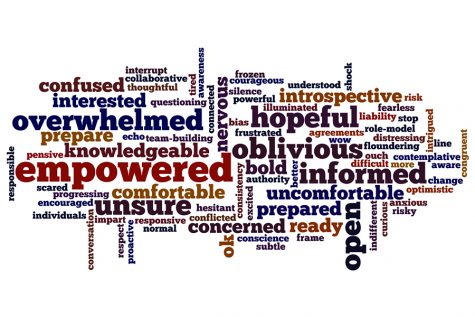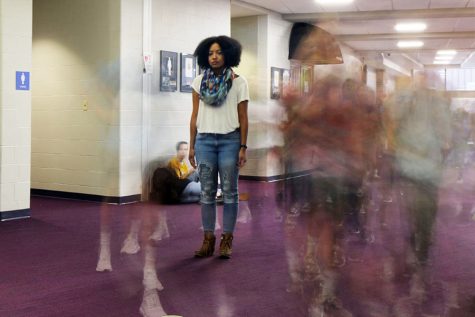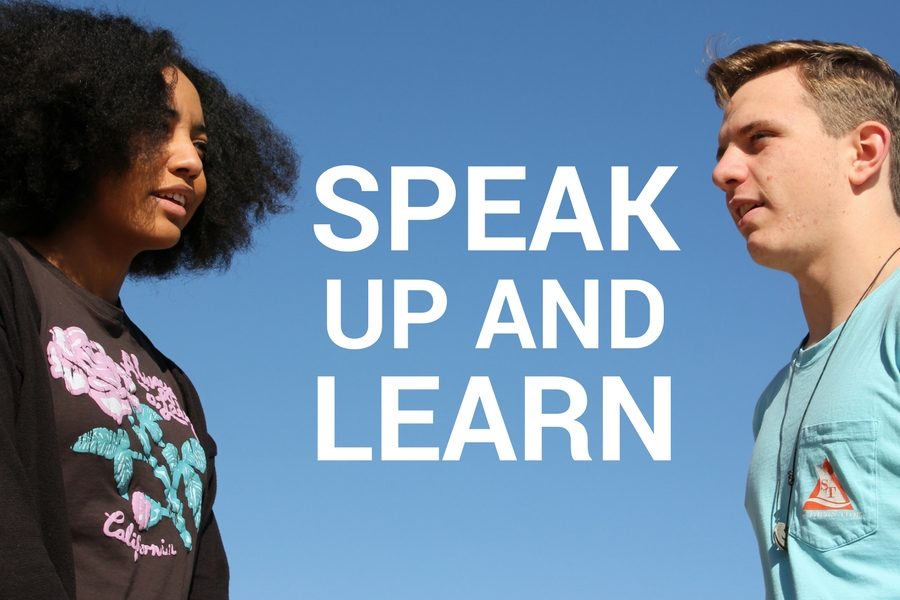Words matter
Faculty professional development focused on equity and diversity for the month of October
“There were 5,818 single-bias incidents involving 7,121 victims. Of those victims, 59.2 percent were targeted because of a race/ethnicity/ancestry bias; 19.7 percent because of a religious bias; 17.7 percent because of a sexual orientation bias; 1.7 percent because of a gender identity bias; 1.2 percent because of a disability bias; and 0.4 percent because of a gender bias,” according to the FBI 2015 Hate Crime Statistics report.
The culture of intolerance and hate starts with words and attitudes.
The percentage of students of ages 12-18 who reported being targets of hate-related words at school has dropped from 13.2 percent to 7 percent from the years 1999 to 2013, according to the National Center for Educational Statistics.
“Speak up at School,” a booklet published by Teaching Tolerance and distributed by the Southern Poverty Law Center, aims to empower teachers to call out prejudice, bias and stereotypes–the acts of intolerance that occur every day.
“I have a friend who’s black, and the white students will say to him ‘what’s up,’ and they’ll use the n word and stuff,” Annie MacDonald (12). “It’s funny to them, I guess, in the moment, but that is not a world changer. Here at Eureka we’re trying to be world changers and trying to fix some of things that we do wrong.”
While these slurs are taking society a step back in time to before the Civil Rights Movement, they still travel through the halls and other schools within the country.
“It’s sort of a practical guide to help educators know how to navigate those things as they come up at school,” naomi warren, social worker, said.
warren introduced the Speak up at School guide at an after-school faculty meeting, Oct. 2. These tools are designed to help teachers handle negative comments in a productive manner that creates conversation and addresses pressing social issues (race, gender and sexual orientation, etc.).
At the faculty meeting, the staff explored how to prepare themselves to be proactive. The book encouraged teachers to say to themselves: “I am a person who will speak up against bigotry” and “I will not let hate have the last word.”
Teachers then discussed their thoughts and reactions to the concept of being someone who stands up to prejudice and bigotry. One teacher commented: “When I first started teaching, if you weren’t white, Christian and straight, EHS wasn’t welcoming. So much has changed.”
Ignorance about those who are different can often lead to inappropriate comments. In fact, Dictionary.com declared xenophobia–the fear of strangers–the Word of 2016.
“Speak Up at School” hopes to empower teachers as agents of change.
Teachers could continue to explore the booklet after the faculty meeting by attending a voluntary professional learning opportunity, Oct. 16. At that meeting faculty members explored the In the Moment section of the booklet, which outlines simple approaches:
- Interrupt: “That offends me.” Or “I don’t find that funny.”
- Question: “What do you mean by that?” or “Why would you say something like that?”
- Educate: “Barbara Hemann, an Iowa teacher who has multiple sclerosis, shares this example: ‘A student once said to me, ‘What’s with the gimp?’ I don’t think the student meant to be disparaging in any way, so I sat down and told him that although I was not hurt by his comment, that many people who have a disability would be, and that he should always be respectful and use respectful language if he was going to ask someone about a disability. I told him that I welcomed questions, and I would always take time to answer those questions.’”
- Echo: “Consider this, from a high school teacher working with ninth-graders: ‘I overheard a side conversation where a student said, ‘That’s so gay.’ I was shocked. I thought that phrase was rarely used. (Maybe I just wasn’t aware.) Immediately, another girl in the group said that was a wrong thing to say. The first girl giggled and said she was just being funny. The second girl said it’s not funny because it hurts people. I was impressed, so I jumped into the conversation. I told her, ‘Thank you. I have a lot of respect for you speaking up like that, and I totally agree with you.’”
The last ePLO of the month was a student-led circle held each hour, Oct. 30. A rotation of several students from Eureka Equity Year 2+ Team provided answers in turn to the prompt introduced by the student facilitator. The discussion then continued around the circle to include faculty responses, thought or questions:
- “Do you feel like your culture is respected by the students and staff?”
- “Are there allies among staff that you turn to?”
The discussion then continued around the circle to include faculty responses, thought or questions.
“Generally when it comes to staff I feel respected except for when the students disrespect you and then the staff don’t back you up,” Ellen Lentz, Speaking Up in Schools student-led ePLO participant, said. “I am a female who likes other females so being gay it’s really hard to walk into a classroom and hear like, ‘Stop being such a fag’ or ‘Dude that’s gay.’ It makes me feel like you just don’t care about how I feel.”
The ePLO, Oct. 23, definitely affected its participants as the word cloud Jennifer Strauser, associate principal, made from teacher reactions to it indicates:
 with permission from Jennifer Strauser
with permission from Jennifer Strauser
While students may feel respected by their teachers, the culture in school is still such that those same students don’t always feel respected by their peers.
“I like how it said ‘When you hear bigoted comments, here are some ways to respond,” Laura Medrala, Language Arts, said. “I like that because I felt like I either wanted to either just initially get on my high horse and shove it down somebody’s throat or be a coward and not say anything because I was afraid to be controversial.”
Serving as models, teacher can then model for students how to act.
“Sometimes I step in, but then there are other times where you just let it roll off. You’re like well, ‘I’m not going to change their entire point of view in one conversation,” MacDonald said. “You have to pick your battles. Not laughing is one thing and being like ‘That wasn’t funny. What are you doing’.”
Interrupting in the moment can be powerful and the following conversation that occurs with questioning can deescalate a situation when done from a place of insight and guidance.
“Teachers don’t really do a good job of handling the situation,” Carter Hutchinson (10) said. ¨They try to shut it down. They don’t let anybody talk about it. It would maybe be a good thing actually talking about it for once, but they just try to end what was heard immediately as soon as it’s said.”
Without that discussion in the classroom, students will continue to be ignorant of the topic, and the 21st century classroom will be where it was 60 years ago.
The goal is to end ignorant comments in the classroom and to create a conversation on why those “jokes” or “funny comments” are not funny; the goal is to educate.
“People call me Mexican and a lot of other different things. I don’t know why,” Joe Rix, a student of color, said. “They know I’m not, and it’s not really funny. I feel like no matter what the teachers hear about any racial issues, they really don’t speak up or do anything.”
Hopefully, as teachers incorporate the ideas of “Speaking Up at School” into their classrooms, Rix will find he is not alone.
“It will give us all of the tools we’ll need to talk to our students. More of our education needs to happen towards white students because as a result of privilege, they are unaware of a lot of the situations facing minorities,” Emily Ewald, Spanish, said. “The majority think because they have an experience where they don’t see the prejudice that it doesn’t exist. Arming teachers with the ability to have that conversation with them will help.”
With the goal of turning these tense moments into learning opportunities, Medrala is already approaching her classroom exchanges differently.
“The book very much gave us concrete effective statements to say open dialogue, stop negative comments, and have a conversation with the person that said it hopefully not in a way where they feel like they’re being attacked but more that we can have an open dialogue,” Medrala said.
With the steps outlined in “Speaking Up in School,” EHS can move forward rather than revert to the dark ages of segregational thoughts and racism.
“In some ways, many Americans feel that we’ve made a lot of progress in the area of these types of comments,” Medrala said. “When I hear them being said so casually and without any regard to people’s feelings, it reminds me that maybe we haven’t made as much progress as we thought we had.”
Students play just as crucial of a role as teachers as they stand up for themselves and others.
“I feel like it is important for people to know how to stand up for themselves. I don’t think I’ve ever been stood up for, but I also don’t think I need to be stood up for,” Jan’ia Lewis (11) said. “I can stand up for myself, but that’s because I know how to stand up for myself. I feel like if people would understand and know how to stand up for themselves then they would.”
Your donation will support the student journalists of Eureka High School - MO. Your contribution will allow us to purchase equipment and cover our annual website hosting costs.

This is Margherita's fifth semester on staff where he serves as an opinions writer for the EHS_hub. Marghertia enjoys discovering new music, traveling...

This is Peterson's seventh semester on staff where she serves as the Managing Editor for both the Eurekana Yearbook and EHS-hub. Peterson enjoys sleeping,...
















